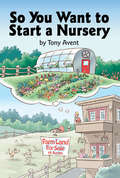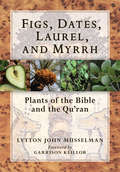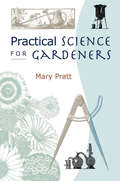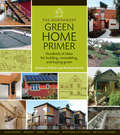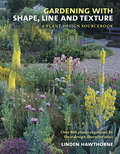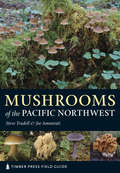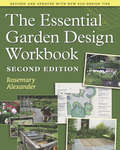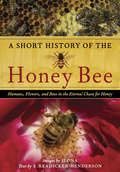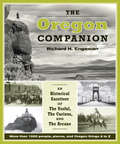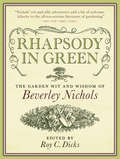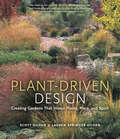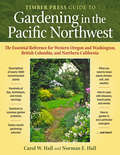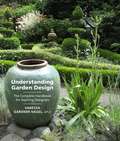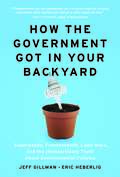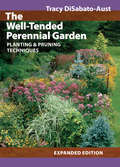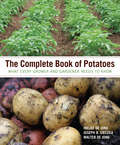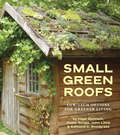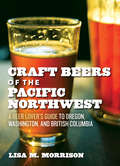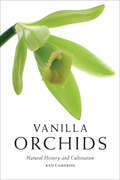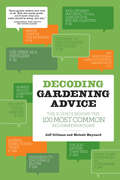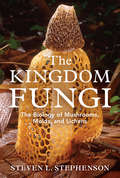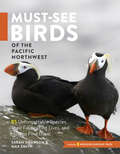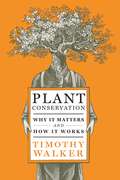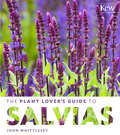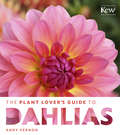- Table View
- List View
So You Want to Start a Nursery
by Tony AventWhen Avent announced that he was quitting his job to build a specialty nursery, his former horticulture professor begged his student to reconsider, telling him he couldn't possibly make a profit "without doing something illegal." More than ten years and 20 nursery catalogs later, Avent owns a thriving national business with nearly 30 employees. He wrote So You Want to Start a Nursery to debunk myths about the ornamental-plants nursery business and what it takes to succeed, whether you're a backyard hobbyist or a wholesale grower. (And he still has a clean arrest record.) Assuming that the reader has some basic knowledge about how plants are grown, Avent focuses on the business and planning concerns of the nursery owner. While recounting humorous stories of his baptism by fire as a beginning nurseryman, Avent also provides a primer on the nursery industry as a whole, with discussions of the merits and disadvantages of retail, wholesale, mail-order, and liner operations, to name just a few. Readers of this book will obtain the tools they need to make a business plan of their own. This book is a must-read for horticulture students, industry insiders, and advanced gardeners who dream of turning their passion for plants into a job they love.
Figs, Dates, Laurel, and Myrrh: Plants of the Bible and the Quran
by Lytton John Musselman Garrison KeillorThis book celebrates the plants of the Old Testament and New Testament, including the Apocrypha, and of the Quran. From acacia, the wood of the tabernacle, to wormwood, whose bitter leaves cured intestinal worms, 81 fascinating chapters—covering every plant that has a true botanical counterpart—tell the stories of the fruits and grains, grasses and trees, flowers and fragrances of ancient lore. The descriptions include the plants' botanical characteristics, habitat, uses, and literary context. With evocative quotations and revelatory interpretations, this information is all the more critical today as the traditional agrarian societies that knew the plants intimately become urbanized.The unusually broad geographic range of this volume extends beyond Israel to encompass the Holy Land's biblical neighbors from southern Turkey to central Sudan and from Cyprus to the Iraq border.Richly illustrated with extensive color photography and with a foreword by the incomparable Garrison Keillor, this delightful ecumenical botany offers the welcome tonic of a deep look into an enduring, shared natural heritage.
Practical Science for Gardeners
by Mary PrattInformative and entertaining, this book will stimulate experimentation and encourage gardeners to review and improve their current gardening practices. Once gardeners learn how plants are constructed, it is easier to envision how they'll grow and flourish. An understanding of the structure behind good, healthy soil gives clues as to how to improve one's own garden tilth. This practical guide helps readers identify what plants need to survive and how these fundamental scientific facts are at the heart of good plant care. A chapter on seeds and germination will encourage gardeners at any level to try their hand at propagation, while discussion of soil, pests, and diseases adds to the skills of all gardeners. The final sections of the book take a closer look at biodiversity, ecology, genetic engineering, and nomenclature. For the enthusiastic beginner or the master gardener, Practical Science for Gardeners unravels the mysterious inner life of plants.
The Northwest Green Home Primer
by Kathleen Smith Kathleen O'BrienThe essential, real-world, green home manual Everyone can make green home decisions on a budget with this inspiring, informationpacked guide. Whether you are building, remodeling, buying, or just curious, here are real-world strategies for getting the greenest results from your budget, with hundreds of ideas for a home that is built to last, comfortable and healthy, money- and time-saving in the long term, and kind to the planet. From your home's exterior to its operating systems within, from siting to interior design, this is the basic training that has given many the confidence to proceed. Award-winning sustainable design and building consultant and teacher Kathleen O'Brien and architectural designer and sustainability consultant Kathleen Smith offer their "top picks" for each phase. They've also each faced their own green home challenges in a single-family house and a duplex, and other case studies show affordable energy-efficient green homes both old and new. Brimming with ideas, clear and logical, with tips, checklists, and resources for green home planning, construction, remodeling, and maintenance, extensively illustrated with photos and diagrams, this is the essential green home manual for novice and professional alike.
Gardening with Shape, Line and Texture: A Plant Design Sourcebook
by Linden HawthorneGardening with Shape, Line and Texture bridges the gap between garden design books and plant reference encyclopedias. Leading landscaper Linden Hawthorne looks at plants from a designer's perspective (where color is often a secondary consideration) and emphasizes the important roles of plant shape. Part One reviews fine art principles and shows how they can be successfully applied to plant compositions by grouping plants into three heights: ground to knee, knee to navel, and navel to crown. She identifies different plant shapes—buns, mounds, tiers, fountains, uprights—and shows how the use of them contributes to the success of the finished design. Part Two is a plant sourcebook with plants listed alphabetically within their key plant shape categories. This innovative plant reference delivers plant information in a form that neatly dovetails with the garden design process and will inspire gardeners to look beyond color and begin to appreciate the whole plant.
Mushrooms of the Pacific Northwest: Timber Press Field Guide (A Timber Press Field Guide)
by Joe Ammirati Steve TrudellExplore the heart of mushroom country The Pacific Northwest is one of the best places to find mushrooms—they are both abundant and spectacularly diverse. Yet until now, there has been no mushroom guide that focuses on the region. This compact, beautifully illustrated guide presents descriptions and photographs of 460 of the region's mushrooms. In addition to profiles on individual species, Mushrooms of the Pacific Northwest also includes a general discussion and definition of fungi, information on where to find mushrooms and guidelines on collecting them, an overview of fungus ecology, and a discussion on how to avoid mushroom poisoning.
The Essential Garden Design Workbook: Third Edition
by Rosemary AlexanderThe Essential Garden Design Workbook guides the reader through every stage of planning a garden — how to survey a site, how to choose landscaping materials, and how to develop planting schemes. This fully revised and updated second edition features new U.S. case studies and new photographs. Valuable tips on green gardening are new to this edition, and include how to harvest rainwater, how to design a green roof, tips on sustainable planting, and a guide to composting. Tailor-made for hands-on gardeners, the workbook approach is accessible, practical, and can be used to create a garden from scratch and to redesign an existing garden. Gardeners will find easy ways to measure large spaces, estimate the height of a tree, and find the right proportions for a deck. They'll also find tips on space, light, and color. Includes hundreds of easy-to-follow line drawings and diagrams.
A Short History of the Honey Bee: Humans, Flowers, and Bees in the Eternal Chase for Honey
by E. Readicker-Henderson Ilona McCartyThere are around 16,000 species of bee. Only seven of these are responsible for creating the world's sweetest treat—honey. Combining Ilona's gorgeous photography and E. Readicker-Henderson's engaging text, A Short History of the Honey Bee follows the journey from flower to hive to honey throughout history.A Short History of the Honey Bee starts with the story of the honey bee—why it is named Apis mellifera, how it has evolved from a solitary creature to one that travels in groups, why it stings, and how pollination really works. Readicker-Henderson then moves on to the honey, detailing its history from a wild food foraged for on cliffs to the many varieties available for purchase today. But it is the everyday importance of the bee that remains the central message. Forty percent of the world's food supply—including apples, tomatoes, and strawberries—is dependent on pollination by honeybees. Colony collapse, when the worker bees suddenly disappear and leave behind the queen and the hive, is an ecological and agricultural crisis. For this reason alone we need to be more aware of the significance of bees.
The Oregon Companion: An Historical Gazetteer of the Useful, the Curious, and the Arcane
by Richard H. EngemanWhat's the connection between Ken Kesey and Nancy's Yogurt? How about the difference between a hoedad and a webfoot? What became of the Pixie Kitchen and the vanished Lambert Gardens?The Oregon Companion is an A–Z handbook of over 1000 people, places, and things. From Abernethy and beaver money to houseboats, railroads, and the Zigzag River, an intrepid public historian separates fact from fiction — with his sense of humor intact. Entries include towns and cities, counties, rivers, lakes, and mountains; people who have left a mark on Oregon; industries, products, crops, and natural resources. Includes more than 160 historical black and white photos. This entertaining and delightfully meticulous compendium is an essential reference for anyone curious about Oregon.
Rhapsody in Green: The Garden Wit and Wisdom of Beverley Nichols
by Beverley Nichols Roy C. DicksBeverley Nichols (1898–1983) was a prolific author, playwright, composer, and media personality. Though much of his work has been forgotten, his garden writing has stood the test of time. His amusing anecdotes, poetic contemplations, and penetrating observations speak to all gardeners—from houseplant killers to nursery professionals—and capture the joy, heartache, and hilarity of gardening.Rhapsody in Green speaks to the true spirit of Beverley Nichols. Compiled by Roy C. Dicks and drawn from fifteen of his best titles, these carefully selected passages offer a tantalizing taste of Nichols's humor, passion, and poetry. Designed for easy browsing and casual reference, it is organized by subject, including favorite plants, despised plants, and the secrets to successful gardening. Readers will also delight in William McLaren's original line drawings spread throughout the text. A must-have for Nichols fans, gardeners, and plant lovers.
Plant-Driven Design: Creating Gardens That Honor Plants, Place, and Spirit
by Scott Ogden Lauren Springer OgdenFor too long, garden design has given pride of place to architecture, artifice, and arbitrary principles. The results? Soulless landscapes where plants play subordinate roles.With passion and eloquence, Scott Ogden and Lauren Springer Ogden argue that only when plants are given the respect they deserve does a garden become emotionally resonant. Plant-Driven Design shows designers how to work more confidently with plants, and gives gardeners more confidence to design. The Ogdens boldly challenge design orthodoxy and current trends by examining how to marry plantsmanship and design without sacrificing one to the other.Supported by extensive lists of plants adapted to specific purposes and sites, Plant-Driven Design explores how plants interact with place. In addition, the authors' experience gardening and designing in a wide variety of climates gives their perspective a unique depth. In ideas, scope, and detail, this book both embraces and transcends regionality. By reclaiming gardens as a home to plants, this groundbreaking work will restore life-affirming vitality to garden design and profoundly affect how we understand and experience gardens.
The Timber Press Guide to Gardening in the Pacific Northwest: The Essential Reference For Western Oregon And Washington, British Columbia, And Northern California
by Carol W. Hall Norman E. HallTired of being lumped into the unwieldy category of a western garden? Frustrated by the lack of reliable, practical information about gardening in the Pacific Northwest? No longer! The Timber Press Guide to Gardening in the Pacific Northwest presents all the information a gardener—whether novice or expert—needs to keep their garden beautiful and thriving. With a combined 100 years of gardening experience in the Pacific Northwest, the authors clearly explain the unique challenges and joys of gardening in the region. By dividing the Pacific Northwest into seven subregions, they help readers to better understand the climatic and geographical factors that shape their gardens. This complete guide includes extensive profiles of plants that are ideally suited to the region, including perennials, ornamental grasses, bulbs, groundcovers, roses, shrubs, trees, and climbers. The month-by-month gardening calendar describes what weather patterns to expect, what's in bloom, and what garden tasks are best done in that month. With additional chapters detailing the most common gardening problems and recommendations for effective, nontoxic ways of dealing with them, this book is nothing short of essential.
Understanding Garden Design: The Complete Handbook for Aspiring Designers
by Vanessa Gardner Nagel APLDDesigning a garden is a complex task. Where do you start? What kind of skills do you need? What are the logical steps in creating a design? How do you communicate your ideas to a client, and how do you accommodate a client’s requests while maintaining the integrity of the project? The answers to these questions, and many more, can all be found in Understanding Garden Design.Most books on garden design focus on only one or a few aspects of garden design—choosing plants or creating a hardscape, for example. This comprehensive, accessible book lays out the entire process from start to finish in clear, precise language that avoids the pitfalls of “designspeak.” In fact, garden owners and clients of garden designers who want to understand more about the designer’s craft will be able to profit from the book’s lessons.Among the many topics covered are how to document a site, how to determine what a client needs and wants from the garden, how to take architectural features into consideration, how to think about circulation and lay out paths, how to use basic design principles, how to work with plants, and how to create a final design. Practical aspects are clearly laid out, including working with contractors and staying on top of the various phases of construction. This thorough handbook is profusely illustrated with helpful photographs and diagrams. A particularly interesting tool is the hypothetical garden plan that appears in each chapter to show how to apply the topics at hand. A practical, logical approach to the planning, design, and installation of a garden, this volume will be an invaluable resource for students, landscape professionals, and garden designers.
How the Government Got in Your Backyard: Superweeds, Frankenfoods, Lawn Wars, and the (Nonpartisan) Truth About Environmental Policies
by Jeff Gillman Eric HeberligBiotechnology—the future or a genetic time bomb? Renewable fuels—the key to cleaner air or just corporate welfare? Greenhouse gasses—baking the earth to death or just a needless worry? Plant patents—improving gardens and farms or just profiteering? When you stop to think about it, the government has its hand in every important environmental issue. And with the left and the right raucously disagreeing about whether the government’s policies are for good or for evil, it’s impossible for a concerned citizen to know what to think.How the Government Got in Your Backyard distills the science, the politics, and the unbiased, nonpartisan truth behind hot-button environmental issues from pesticides to global warming. By clearly representing what the left says, what the right says, what the science is, and what the facts are, Gillman and Heberlig don’t set out to provide the answer—they light the path so concerned citizens can uncover their own true and informed opinion. In this season of political discontent, the unbiased truth about environmental policies—free of political agendas—is as refreshing as it is fascinating.How the Government Got in Your Backyard is not for Republicans or Democrats, liberals or conservatives. It’s for anyone who is ready to get to the bottom line.
The Well-Tended Perennial Garden: Planting & Pruning Techniques
by Tracy DiSabato-AustWith more than 180,000 copies sold since its original publication, The Well-Tended Perennial Garden has proven itself to be one of the most useful tools a gardener can have. Now, in this expanded edition, there's even more to learn from and enjoy. This is the first, and still the most thorough, book to detail essential practices of perennial care such as deadheading, pinching, cutting back, thinning, disbudding, and deadleafing, all of which are thoroughly explained and illustrated. More than 200 new color photographs have been added to this revised edition, showing perennials in various border situations and providing images for each of the entries in the A-to-Z encyclopedia of important perennial species. In addition, there is a new 32-page journal section, in which you can enter details, notes, and observations about the requirements and performance of perennials in your own garden. Thousands of readers have commented that The Well-Tended Perennial Garden is one of the most useful and frequently consulted books in their gardening libraries. This new, expanded edition promises to be an even more effective ally in your quest to create a beautiful, healthy, well-maintained perennial garden.
The Complete Book of Potatoes: What Every Grower and Gardener Needs to Know
by Hielke De Jong Walter De Jong Joseph B. SieczkaThe only comprehensive resource for home gardeners and commercial potato growers, The Complete Book of Potatoes has everything a gardener or commercial potato grower needs to successfully grow the best, disease-resistant potatoes for North American gardens. Includes practical as well as technical information about the potato plant, its origin, conventional and organic production techniques, pest management, and storage practices. The plant profiles include still life photographs of the exterior and interior of the tuber, and a succinct description of each variety’s physical and culinary qualities.
Small Green Roofs: Low-Tech Options for Greener Living
by Nigel Dunnett Dusty Gedge John Little Edmund C. SnodgrassUntil now, the green roof movement has been limited to large-scale, professional endeavors and public buildings. But homeowners everywhere are catching onto the benefits of a green roof—water conservation, energy savings, and storm water management. In Small Green Roofs authors Dunnett, Gedge, Little, and Snodgrass profile ordinary homeowners who scaled green roofs down to the domestic level.Small Green Roofs is the first book to focus on small-scale and domestic green roofs. More than forty profiles of small and domestic-scale projects of all shapes and sizes include green roofs on sheds, garden offices, studios, garages, houses, bicycle sheds, and other small structures, as well as several community projects. For each project, details are given for design, construction, and installation, as well as how-to tips on how the roof was planted and cared for. For readers looking for inspiration when hiring a contractor or taking the adventurous step of building their own, Small Green Roofs provides the knowledge and encouragement to make it possible.
Craft Beers of the Pacific Northwest: A Beer Lover's Guide to Oregon, Washington, and British Columbia
by Lisa M. MorrisonIn the 1970s a handful of brewers in Oregon, Washington, and British Columbia were tired of the traditional light and flavorless American beers and began exploring ways to make better beer brewed from local ingredients. The “microbrews” (as they were originally called) caught on, and the Northwest quickly became the center of the craft beer movement that is now flourishing and spreading across the United States, Canada, and the world. Craft Beers of the Pacific Northwest is a suds-soaked adventure through the 115 key breweries and brew pubs in Oregon, Washington, and British Columbia. Lisa Morrison, aka The Beer Goddess, has included every brewery worth visiting, from pioneers like McMenamins, whose Hillsdale Brewery & Public House in southwest Portland was the first brewpub in Oregon, to a new generation of start ups like Upright Brewing, a production brewery that is creating French-Belgian inspired, open-fermented beers.With 18 walkable pub-crawls, a beer primer and glossary, a list of the best bottle shops, Craft Beers of the Pacific Northwest has everything a beer lover needs to navigate the best of what the region has to offer.
Vanilla Orchids: Natural History and Cultivation
by Ken CameronWith more than 30,000 known species, orchids represent the largest family of plants. But only one genus has agricultural value—the Vanilla orchid. Leading orchid expert Ken Cameron covers the natural history of the world’s most popular flavor and fragrance and provides an introduction to the pollination, biology, structure, evolution, and diversity of Vanilla and related orchids. Vanilla Orchids also features methods for bean harvest, curing, and processing for enthusiasts who want to try it at home.
Decoding Gardening Advice: The Science Behind the 100 Most Common Recommendations
by Jeff Gillman Meleah MaynardCovering more than 100 universal gardening "dos and don'ts," Decoding Gardening Advice is the first book to provide gardeners with the real answers. Jeff Gillman, the bestselling author of The Truth About Garden Remedies, and Meleah Maynard back up every good recommendation with sound horticultural and botanical science. Decoding Gardening Advice is the first and only hard-hitting, evidence-based book that every gardener needs for definitive advice on everything from bulbs, annuals, and perennials to edibles, trees, and soil care.
The Kingdom Fungi: The Biology of Mushrooms, Molds, and Lichens
by Steven L. StephensonThe ubiquitous fungi are little known and vastly underappreciated. Yet, without them we wouldn’t have bread, alcohol, cheese, tofu, or the unique flavors of mushrooms, morels, and truffles. We can’t survive without fungi. The Kingdom Fungi provides a comprehensive look at the biology, structure, and morphological diversity of these necessary organisms. It sheds light on their ecologically important roles in nature, their fascinating relationships with people, plants, and animals, and their practical applications in the manufacture of food, beverages, and pharmaceuticals. The book includes information about “true” fungi, fungus-like creatures (slime molds and water molds), and a group of “composite” organisms (lichens) that are more than just fungi. Particular attention is given to examples of fungi that might be found in the home and encountered in nature. The Kingdom Fungi is a useful introductory text for naturalists, mycologists, and anyone who wants to become more familiar with, and more appreciative of, the fascinating world of fungi.
Must-See Birds of the Pacific Northwest: 85 Unforgettable Species, Their Fascinating Lives, and How to Find Them
by Sarah Swanson Max SmithMust-See Birds of the Pacific Northwest is a lively, practical guide that helps readers discover 85 of the region’s most extraordinary birds. Each bird profile includes notes on what they eat, where they migrate from, and where to find them in Washington and Oregon. Profiles also include stunning color photographs of each bird. Birds are grouped by what they are known for or where they are most likely to be found—like beach birds, urban birds, colorful birds, and killer birds. This is an accessible guide for casual birders, weekend warriors, and families looking for an outdoor experience. Eight easy-going birding weekends, including stops in Puget Sound, the Central Washington wine country, and the Klamath Basin, offer wonderful getaway ideas and make this a must-have guide for locals and visitors alike.
Plant Conservation: Why It Matters and How It Works
by Timothy WalkerPlants’ ability to turn sunlight into energy makes them the basis for all life; without them there is no life. And they are more than just a food source—they provide us with fuel, fibers, and pharmaceuticals. Global warming and the destruction of natural habitats are a serious threat to many plants, and there are worldwide efforts to mitigate the disaster. Plant Conservation tackles this essential topic head on. Timothy Walker, as the director of the Oxford Botanical Garden, a leader in the field of plant conservation, plays a key role in this effort. He highlights what is happening now, from cataloging the world’s flora to conservation efforts like protecting plants from overcollecting. He also shows home gardeners how they can become involved, whether by growing their own food to decrease reliance on large agriculture or by making smart plant choices by growing natives and avoiding invasives. Plant Conservation treats a critical topic in an accessible and optimistic way. It is required reading for students, professionals, and anyone with a keen interest in the importance of plants.
The Plant Lover's Guide to Salvias (The Plant Lover’s Guides)
by John WhittleseySalvias are available in a huge range of sizes, colors, foliage, and hardiness, with over 900 species and hundreds of hybrids. Salvia’s popularity stems from how easy they are to grow, their multiple medicinal and culinary uses, and the vibrancy of their blooms that cover every color in the spectrum from white to nearly black. The Plant Lover’s Guide to Salvias features everything you need to know to grow this vibrant and fragrant plant. Plant profiles of 150 varieties highlight each plant’s type, habitat, size, hardiness, origin, cultivation, and use in the landscape. Additional information includes tips on design, how to grow and propagate salvia, where to view them in public gardens, and where to buy them.
The Plant Lover's Guide to Dahlias (The Plant Lover’s Guides)
by Andy VernonDahlias are the showgirls of the garden. A favorite of floral and landscape designers, they come in a wide range of jewel-like colors—rich reds and vibrant oranges, shocking pinks—and an engaging variation of form and petal shape. The Plant Lover’s Guide to Dahlias is packed with everything you need to know to grow these fantastic flowers including tips on using dahlias in garden design, growth and propagation information, and lists of where to buy the plants and where to view them in public gardens. The bulk of the book is devoted to profiles for over 200 varieties, organized by color, with information on type, height, and spread. Gorgeous color photographs bring the plants to life.
